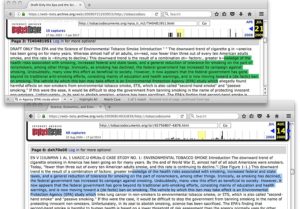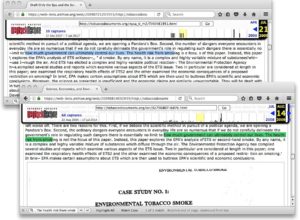What does that have to do with climate science? Absolutely nothing, and by God, any idiot knows breathing second-hand cigarette smoke can’t be good for you. So if anyone or any organization even remotely denies that it is at least harmful in some way, then those people are folks you want to avoid mentioning at all costs, so as not look like a fool yourself. This includes situations where those same folks dare to question the settled science of catastrophic man-caused global warming. It’s all a brilliant setup ….. but there is one eensy-beensy fatal problem here.
Skeptic climate scientists have never said inhaling second-hand cigarette smoke or cigarette smoke was harmless.
If any such skeptic ever offered wording anywhere, written or spoken, in the same vein as the malarkey offered by tobacco industry CEOs, I have yet to find it, and I challenge anyone to show such viewpoints to me. Yet major skeptic scientist figures such as Dr S Fred Singer are said to deny the harm of smoking.
So, who started this accusation? Or more to the point, who was the most influential in spreading it?
I’d argue that Desmogblog’s June 28, 2006 post “No apology is owed Dr. S. Fred Singer, and none will be forthcoming” is probably the culprit here. While not directly stating that Dr Singer said second-hand tobacco smoke was not harmful, who can miss the insinuation in its 4th paragraph? (and, incidentally, notice who is seen in that screencapture in a dig at Dr Singer’s ‘other’ funding two paragraphs later)
… here is the link to a memo in which an official from the Alexis de Tocqueville Institution solicits $20,000 from the Tobacco Institute for the preparation of a “research” paper challenging the health effects of second-hand smoke, and suggesting that Dr. Singer be retained to write the report. Here is the link to a letter thanking the Tobacco Institute for $20,000 intended “to support our research and education projects.” Here is a research paper, [http://tobaccodocuments.org/nysa_ti_m2/TI40481951.html] just as described in the earlier memo, with Dr. Singer’s name as the author. And here is another Tobacco Institute memo, reporting on Dr. Singer’s appearance with two Congressional Representatives releasing the paper to the media.
Golly. We have a guy who not only engages in ‘dubious public relations tactics to skew the climate change debate,’ but there he is writing a paper funded by an organization with some connection to the tobacco industry, which itself would want — what else? — something stating cigarette smoking is not harmful. Desmog’s first memo link is the payment, and then there’s the link to the research paper itself. Well, sort of a link, because when you click on it right now, it goes to a French language site opposing smoking which is otherwise devoid of any documents to look at. Obviously, somebody at the TobaccoDocuments.org site let their registration lapse and it turned into something different.
Ok, the previous iteration of TobaccoDocuments showed everyone what they needed to know, right? Not exactly. In 2013, as I noted here, major parts of that page were behind a sign-in wall. At that time, people who clicked on Desmog’s link would have seen a very plausible-looking page that looks like what the Internet Archive preserved. [Author’s 11/13/20 update: that Internet Archive link changed to this one] The key to this puzzle is what’s obscured there – through lousy optical character recognition (OCR) scan results and missing scanned paper images.
As loyal readers of GelbspanFiles already know, I’m not content with incomplete context, which is why I sought out in the summer of 2009 (months before I began looking for the full context of Ross Gelbspan’s smoking gun ‘corrupt skeptics’ evidence) a readable set of text and scans for the Singer paper that Desmog was referring to. What I quickly found was this file, [Author’s 11/13/20 update: the Internet Archive changed the link] this file, which has the critical scanned page images fully intact that the aforementioned 2013 ‘sign-in requirement page’ didn’t show. How do I know the two are of basically the same Alexis de Tocqueville Institution-prompted ‘research paper’? It’s their unmistakable overlaps of the paper’s wording. The following screencaptures (click each to enlarge) illustrates two of multiple overlaps. It’s an exercise anyone can undertake to corroborate that the two TobaccoDocuments.org files are of the same paper.
What’s the difference between these two files? The upper page in each screencapture composite is Desmog’s link to a draft version of the final paper. In the first screencapture composite, you readily see how the identical words begin at an OCR letter character glitch and end at a revision of the text, and the second one begins and ends with OCR letter glitches. It’s this second screencapture – both draft version and final – that torpedoes whatever intention Desmog had against Dr Singer, and I emphasize it below in red via my own summary copied straight out of the much more readable final paper OCR results. (If anyone doubts the full context, read the scanned pages of the final paper):
(Page 6) The health risk from smoking is not the focus of this paper. Instead, this paper explores the EPA’s analysis of ETS or second-hand smoke … In brief, EPA makes certain assumptions about ETS which are then used to buttress EPA’s scientific and economic conclusions. (Page 7 continuation of the paragraph) Moreover, the science as presented is insufficient….
In the process, it has manipulated both the science and the regulatory process …
(Page 9) Despite the EPA’s conclusion that ETS is a Group A carcinogen, it is at the very least arguable that ETS would flunk each separate step of the three-prong test. And it is the EPA’s effort to cross the final hurdle that has produced the harshest criticism. When its review discovered that existing U.S. studies of lung cancer and ETS did not support its position, the EPA arbitrarily reduced the traditional standard of proof; or “confidence interval ” Only by this manipulation could the EPA claim that its analysis was statistically significant.
Dr Singer never said second-hand smoke wasn’t harmful, he went out of his way to say such a conclusion was not what the paper was about. Clearly it was on the validity of EPA’s own labeling of second-hand smoke as a Class A carcinogen.
And in case anyone forgets, a Federal Judge overturned EPA’s position in 1998.
The controversial EPA report concluded environmental tobacco smoke is a Class A carcinogen, as hazardous as radon and responsible for some 3,000 lung cancer deaths each year. The tobacco industry promptly sued in federal court to force the study to be withdrawn, arguing that the agency ignored accepted scientific and statistical practices in making its risk assessment — a contention made at the same time by many independent scientists.
Dr Singer was one of those independent scientists. It should also be added that in his 2010 “Secondhand Smoke [SHS], Lung Cancer, and the Global Warming Debate” piece at AmericanThinker, he said this (5th paragraph):
I am a nonsmoker, find SHS to be an irritant and unpleasant, have certainly not been paid by Philip Morris and the tobacco lobby, and have never joined any of their front organizations. And I serve on the advisory board of an anti-smoking organization. My father, who was a heavy smoker, died of emphysema while relatively young. I personally believe that SHS, in addition to being objectionable, cannot possibly be healthy.
So, the ‘King Denier about the harm of cigarettes’ essentially said smoking kills and second-hand smoke “cannot possibly be healthy.” Now, the question remains: Did Desmogblog use Dr Singer’s draft copy knowing its content was advocating proper scientific classification of second-hand smoke against an agency trying to say SHS was a carcinogenic killer, and was thus worthless as a means of portraying him as an anti-science, tobacco-promoting, ‘harmful cigarettes denier’? Or were they so spectacularly ignorant about the matter that they didn’t even bother to read their own “evidence?”
————————————————————————
Part 2: another example of folks pointing to evidence which isn’t there


